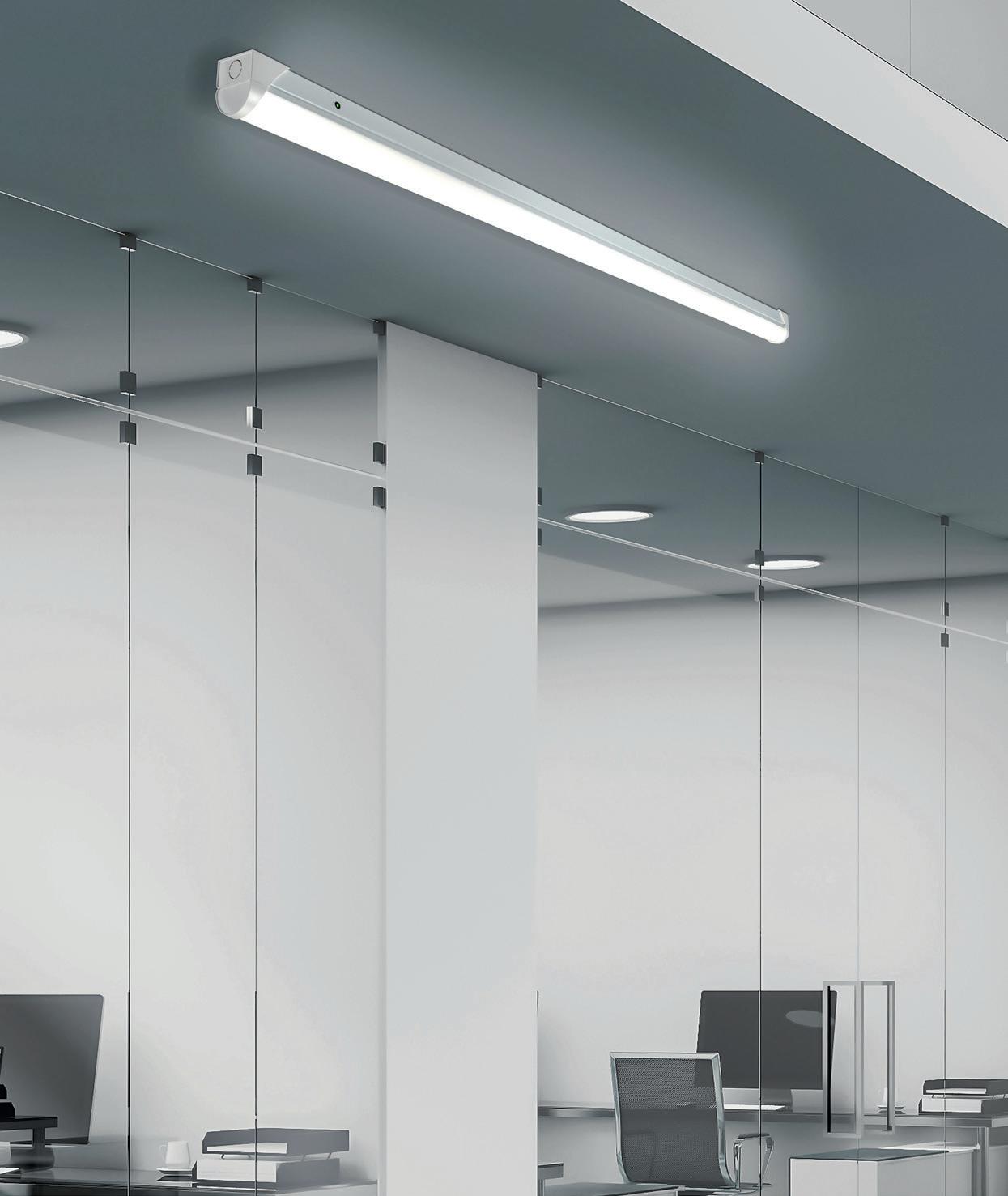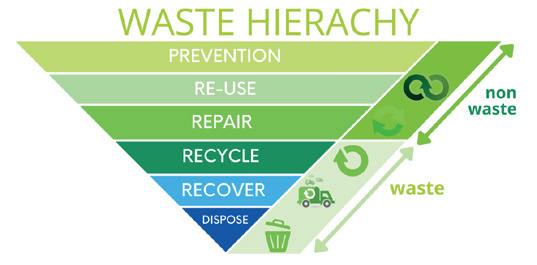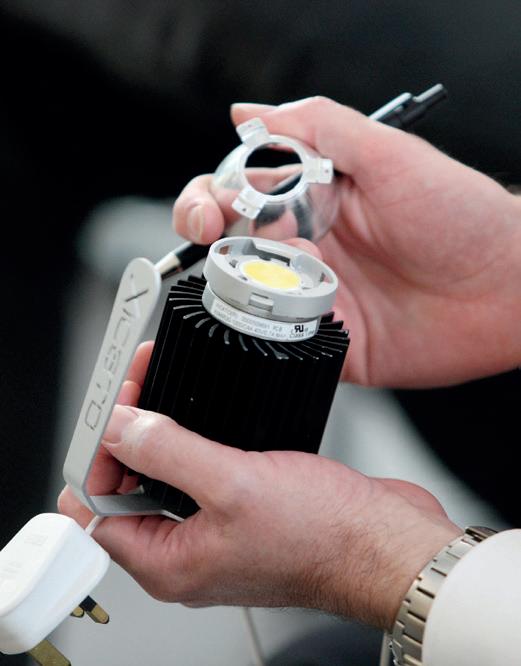
9 minute read
Lighting
How LED lighting is transforming the industry landscape
Fluorescent battens have been a stalwart of commercial and industrial installations, but LED technology brings a whole host of new benefits as well as regulatory compliance, writes Scott Brewer, Head of Technical at Knightsbridge.
Advertisement
I
t would be hard to argue against the assertion that LED lighting is now the predominant lighting source for UK residential, retail and commercial applications. Industry researchers IBISWorld estimates that sales for LED products and ancillaries are over £2.5 billion annually.
While other mainstream lighting sources have fallen by the wayside, the LED world has exploded. There’s probably not a house, office or retail shop in the UK that doesn’t have LED lamps installed somewhere. According to findings from German electrical magazine Reichelt, 73% of UK consumers are already reaping the benefits of using LED lamps in their home, with 17% of respondents having already switched to LED lights completely.
In the commercial sector, the fluorescent batten has come a long way since American electrical engineer and inventor Peter Cooper Hewitt and German physicist Leo Arons pioneered the first mercury vapour lamps in 1901. The fluorescent tube came into being 30 years later when a phosphor coating was added to the inside of the tube to improve the quality of the light output.
Fast forward to now and LED is the future and the way forward, offering superior performance across a whole range of metrics – efficiency, cost, design, and most importantly, speed of installation.
So what does this new generation of LED battens ‘look like’? And what can be expected from them?
Probably the first thing to say is that dimensions-wise, LED battens are available in the same sizes as their fluorescent predecessors, making them ideal for retrofit installations, while not forgetting their potential for new-build environments. For example, proprietary fast-fix LED batten ranges come in lengths of between two and six feet, so refurbishing existing schemes isn’t a problem.
The next benefit is the sheer efficiency of which LED battens are capable, with lamps producing upwards of 120 lm/w eclipsing the typical 40-100 lm/w from, say, a conventional T5 or T8 lamp. In addition, the quality of light is generally better, and the light distribution is improved, reducing unwanted glare which can be disruptive in office or commercial situations.
As with many products, the adoption of electronics has helped improve not only efficiency but also the versatility of LED battens. One can now expect to see LED battens that have an emergency lighting function, or a sensor control that detects movement with all the additional environmental and cost benefits that technology brings. For instance, emergency ranges can include a lithium-ion battery capable of storing more energy than the traditional nickel cadmium version, providing extended duration for emergency lighting in the event of a power outage.
And perhaps most significantly these advantages have not come at the expense of making LED battens more difficult to install. Ever conscious that time is money, proprietary fast-fix systems have been designed and manufactured to make installation as simple as possible. Push-fit, loop in/loop out terminal block means wiring is quick and easy; hinged gear trays allow untroubled access to lighting bays and end conduit entry makes completion neat and trouble-free.
One consideration when it comes to specifying LED battens is compliance with ErP directives. The new ErP Single Lighting Regulation directive EU 2019/2020 and the Energy Labelling Regulation directive EU 2019/2015 were implemented on Christmas Day 2019, and became enforceable from September 1 last year, replacing the old ErP directives EC 244/2009, EC 245/2009, EU 1194/2012, and directive EU 874/2012. These changed the way lighting energy efficiency is assessed and labelled, as well as the quality of light output of LED lamps and luminaires.
The Energy Labelling Regulation (ELR) changed the old rainbow colour labelling scheme which gave a broad indication of the energy efficiency of a product. It introduced new technical parameters to determine this efficiency, so that the ratings are not like-for-like replacements for the previous scheme. As a result, even previously top-rated products achieving A++ (the maximum for lighting) now come in at anywhere from C to G.
This doesn’t mean that products previously rated A++ perform poorly for having a lower rating, just that the criteria for assessment has changed.
For lighting, there is an 18-month transition period applying which means that existing stocks with the old labels can be sold and displayed side-by-side with new items. From March 1 2023, all products must display the new labels only.
However, many low-quality budget products won’t achieve even a G rating and will have to be removed from sale, improving the overall average performance and energy efficiency of goods on the market.
All light sources with an energy label will have a QR code which will direct you to the ‘EPREL’ register, where more detailed information about the product and its efficiency can be obtained. This can also be used for verification of compliance.
The Single Lighting Regulation (SLR) relates to ‘light sources’ and stipulates certain performance criteria in terms of light output, for example, colour rendering, flicker, stroboscopic effect etc. This more stringent focus on light performance will also see cheaper items removed from the market as upgrading them will be uneconomic, while certain types of lamp will effectively be phased out as they fail to meet the new criteria.
The SLR also places an obligation on manufacturers to improve the replaceability of component parts within luminaires, including a clear labelling scheme to specify which parts can be replaced by the end-user or by a professional.

The drive to a fully sustainable lighting industry
Nigel Harvey, CEO of Recolight, the WEEE compliance and collection scheme for the lighting industry, outlines how we can reduce the environmental impact of lighting by adopting sustainable, circular economy principles.
L
egislative changes and end-users are increasingly placing emphasis on lighting that is truly sustainable – products that are not just energy efficient, but which are also resource efficient. We need to keep products in use for longer, rather than simply discarding them, or needlessly recycling them.
Modular light fittings Resource efficiency seeks to minimise the use of new raw materials in products. This change will require products that are more likely to be modular in design – with replaceable light sources and control gear. That means that if one critical component fails in use, the component can be replaced without having to replace the complete fitting. This improves resource efficiency and saves the embedded carbon footprint associated with making new products.
Reused and remanufactured fittings Another way of improving material efficiency in the lighting sector is to make used fittings available for remanufacture when they are replaced. Reuse like this has much better environmental outcomes than recycling – the body of the fitting is retained, and the light source or control gear can be checked or upgraded. Alternatively, some end-users are starting to specify product upgrades, rather than complete replacements. For example, retrofitting a T8 luminaire with an LED light source. In many instances, this upgrade can be performed on-site, without the need for the products to be returned to the factory.
It is encouraging to see a few tenders emerging where remanufactured products will also be considered alongside new lighting. Awareness that recycling does not usually represent the best outcome for end-of-life luminaires is much higher. That is pleasing because it means end-users
and specifiers are more likely to consider remanufactured products.
Remanufacture can provide a range of benefits to end-users but this must be achieved without compromise on compliance. Remanufacturers need to be diligent in identifying, assessing and testing remanufactured products prior to declaring conformity and placing products on the market, using methods appropriate to production volumes, end application and product type.
If the lighting sector is to become truly sustainable, it will need an ecosystem of companies with expertise in remanufacturing luminaires when they are removed from a building. But rebuilding, upgrading, testing, certifying and reselling lighting products is no easy task.
Wholesalers and contractors can be a vital part of this process, by partnering with companies involved in reuse, and offering reused products for sale.
Recolight can support this transformation whenever companies purchase from Recolight member lighting companies. That support includes providing ‘cardboard bubble-wrap’ to contractors, finding a company willing to reuse or remanufacture the luminaires, and even financing the transport from the site to the recipient company.
Work with companies that are committed to net zero When specifying new fittings, include a requirement for demonstrable commitments to net zero in the purchasing or tender criteria. Even better, give that requirement a visible and material weighting in the bid assessment process. It is important to check that any such claims are credible so there are a number of ways of checking the reality of the claims: 1. Is there visible commitment to the policy from the top of the company? 2. Has the company set short-term plans, actions and targets, not just a long-term “Net zero by 20XX” target? 3. Check the extent of the target. For example, many companies have a target for 2030, but with a disclaimer that it only covers scope 1 and 2.
But for most, the scope 3 use phase is by far the most dominant impact. 4. Is the company’s net zero performance regularly assessed by an independent third-party? 5. Has the company any life cycle assessment data for their products? 6. To what extent does the company rely on carbon offsets? Offsets should only cover absolutely unavoidable, irreducible carbon emissions. And even then, they don’t really work. If the company does use offsets, do they have a plan to reduce reliance?

Recycling and the waste hierarchy We should all relentlessly apply the waste hierarchy: reduce, reuse, recycle – and in that order. For example, greater use of daylight to reduce the number of fittings needed – or indeed to eliminate them in some locations. Prioritise the reuse and refurbishment of old fittings – for example can those T8 fittings be upgraded to LED, rather than disposing of the whole fitting? Do those T5 fittings really need to be replaced? Can they be used for longer?
Only recycle when all else fails – recycling loses most of the embodied carbon in a light fitting. It is rightly at the bottom of the waste hierarchy. it is important to purchase from lighting producers committed to applying the waste hierarchy and to proper recycling. For example, is the producer a member of a WEEE scheme, which offers free of charge collection from their members’ customers (subject to appropriate criteria), and which looks for reuse options before the decision is taken to recycle?

Lighting and the circular economy When specifying new fittings, include demonstrable commitments to the circular economy in the purchasing criteria. Currently, the best way of incorporating this is probably to reference SLL/CIBSE’s TM66 specification. The specification scores a product group against a range of criteria to show the extent to which it embeds circular economy principles. It is currently in beta release, and some of the criteria cannot be reliably and objectively assessed, but it is close.
When finalised, TM66 should make it much more straightforward for specifiers to compare the ‘circularity’ of lighting products.
We can expect to see further growth in circular economy approaches in the lighting industry. We will see more companies designing lighting products for a circular economy, but it will also mean more end-users will be willing to consider product reuse, remanufacture and upgrades, rather than complete product replacements.









